Brussels Griffon Breed Information: Facts, Traits, Pictures & More
When you purchase through links on our site, we may earn a commission. Here’s how it works.
When we adopt a dog as a companion, we’re often thinking of adding a new buddy to a family that includes several human and pet members. The family dog will love and interact with each member differently and adapt as the family changes. However, the time may come when it is just you and you find yourself looking for your very own new best friend. The Brussels Griffon, with his remarkably expressive face and utterly devoted nature, could be the perfect dog for you.
The Griff is known for having a range of facial expressions described as quite human in nature. His ability to encapsulate in a look exactly what he is thinking is a characteristic of the breed, and he loves nothing more than to share it with his special human. Griffs are sensitive and intelligent but fun-loving and full of energy.
Even though they are sometimes referred to as “Velcro dogs” for how closely they stick to the humans they love, Griffs aren’t necessarily the best choice for an on-the-go family with rough and tumble children. Their ideal person would work from home and have time to spend with them both cuddling and doing some daily exercise. They bond strongly with the person who takes care of them, and they hate to be alone.
Table of Contents
Breed History
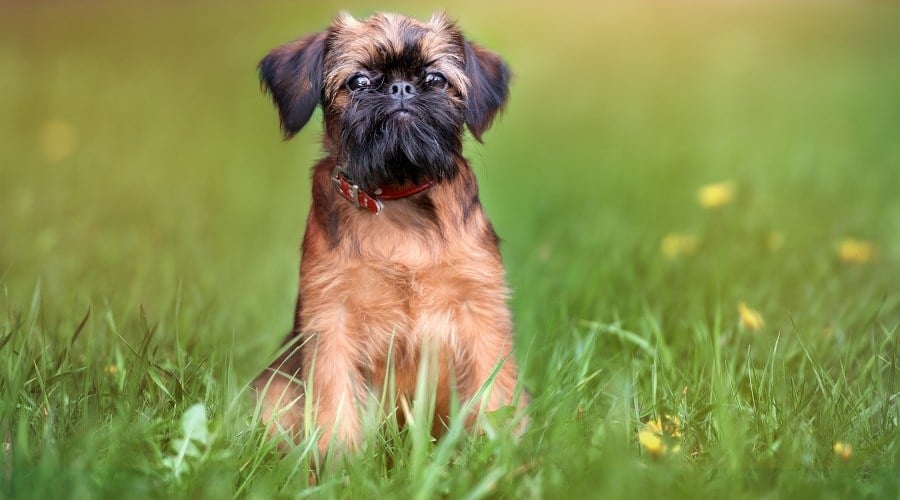
In Belgium, the dogs tasked with this job were like Affenpinschers. They were descriptively called Griffons d’Ecurie, or wire-coated stable dogs. Many of the dog breeds we know and love today were originally crossbreds bred to create the perfect dog for the job. If the creative stable hands who crossed various breeds in the quest for the perfect ratter and stable buddy kept records of the crosses, they were lost to history. Luckily, we have the Brussels Griffon as evidence of their dedication.
The Griffon d’Ecurie crossed with the Pug and created the Brabancon, a smooth-coated Griffon named after the Belgian national anthem. Around the same time in the early 1800s, other English breeds were being added to the mix. Black, Tan, and Ruby varieties of the English Toy Spaniel were introduced to the bloodline. These crosses produced dogs of two coat types and multiple colors. In the United States, they are all now simply varieties of Brussels Griffon, but in Europe, they have been split into three different breeds. They have the rough-coated Brussels Griffon with red/fawn rough coats, the Griffon Belge with rough coats of any color other than red or fawn, and the smooth-coated variety of Brussels Griffon known as the Petit Brabancon.
Modern Griffs no longer rid stables of rats as they did in days gone by but have instead become loyal and loving companion dogs. Griff’s expressive face, strong underjaw, up-tilted nose, and very dark, lustrous eyes that reflect so much expression have made him a fascinating and entertaining best friend. Horsepeople have always had a soft spot for dogs, and companionability and personality clearly were considerations as they created this dedicated breed.
Temperament
Characterized by their absolute devotion to their favorite humans, Griffs wear their emotions on their sleeves, or rather, on their distinctive faces. They delight in your company and may follow you from room to room. The Brussels Griffon’s sensitive nature cannot tolerate teasing or shouting, but one could not ask for a more loving and devoted sidekick when treated with patience and love. His style and intelligence help him excel in the show ring and in obedience and agility competitions.
Size And Appearance
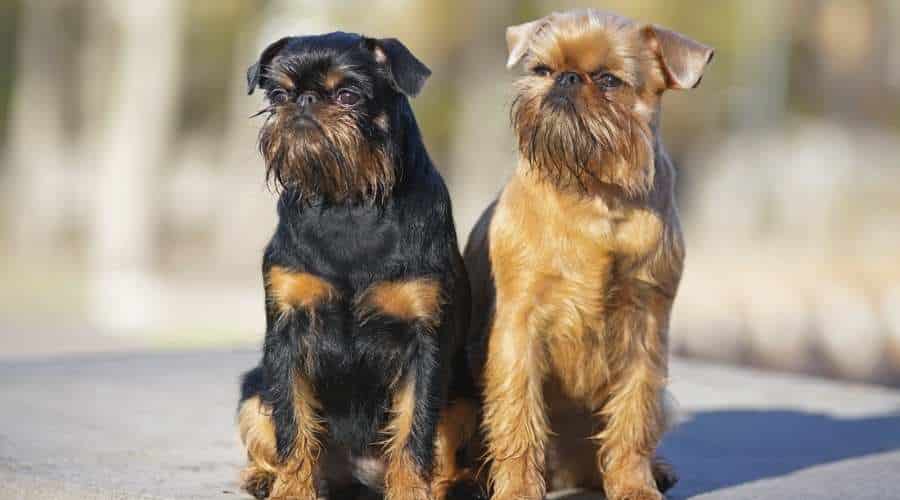
He weighs between 8 and 10 pounds. Despite his small stature, he presents an air of self-importance supported by his square build. His sturdy build reflects the fact the breed was created by people whose livelihoods revolved around horses. Like a good carriage horse, he moves with purpose and his stride has good reach and efficiency. His AKC breed standard describes his body as thickset, compact with good balance, and well boned. The Brussels Griffon carries himself like a much larger dog, but his diminutive size can put him at risk of injury.
Anyone who sees a Brussels Griffon would agree that his face is what makes him so memorable. Behind his distinctive beard, Griff’s skull is large and round with a domed forehead. His wide-set black eyes sit atop a set-back nose and an undershot jaw, the prominence of which gives him a misleadingly defiant look.
Coat And Colors
Brussels Griffons come in four colors. Self-explanatory are black and tan, black, and red, but the fourth requires further description. The fourth AKC recognized color is “belge,” which is black mixed with reddish-brown, generally with a black mask and whiskers. Griffs cannot have any white hairs in their coat unless they are greying around the muzzle due to old age.
There are two types of coats per the AKC breed standard, the rough and the smooth. The rough coat should be dense and wiry with no trace of silkiness. The rougher his coat, the better, but he is not shaggy or unkempt. His coat should not be trimmed with clippers or scissors but hand-stripped.
Hand-stripping is a process for removing the old hair from your Griff’s rough coat. When the old coat is ready to come out, it will pull easily and painlessly from the skin and allow the new seasonal coat to come in. A professional groomer can perform this service for you and your pup.
Exercise Requirements
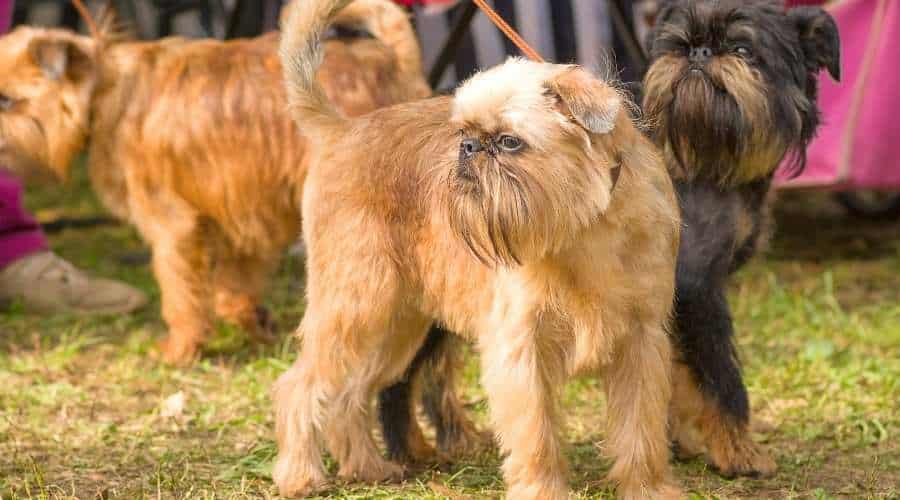
Tossing a ball for your Griff or taking him on a peaceful stroll for about thirty minutes per day will keep him healthy and happy. The most important thing is that he’ll relish the time the two of you are spending together.
Because of his brachycephalic facial structure, pay particular attention to his breathing if the two of you go jogging, and be careful as the temperatures soar in the summertime. Moderate exercise will help him avoid excess weight and the associated health problems.
Living Conditions
Brussels Griffons may have originated in the stables of 19th century Belgium but after nearly two centuries of selective breeding, they are best suited as indoor dogs. They do not handle extremes of temperature well and will appreciate air conditioning in the summer and heat in the winter. The Griff does not handle loneliness well, but his small size may also make him a target for predatory animals even in his own backyard. They have little homing instinct and need to be protected from their own curiosity.
Training
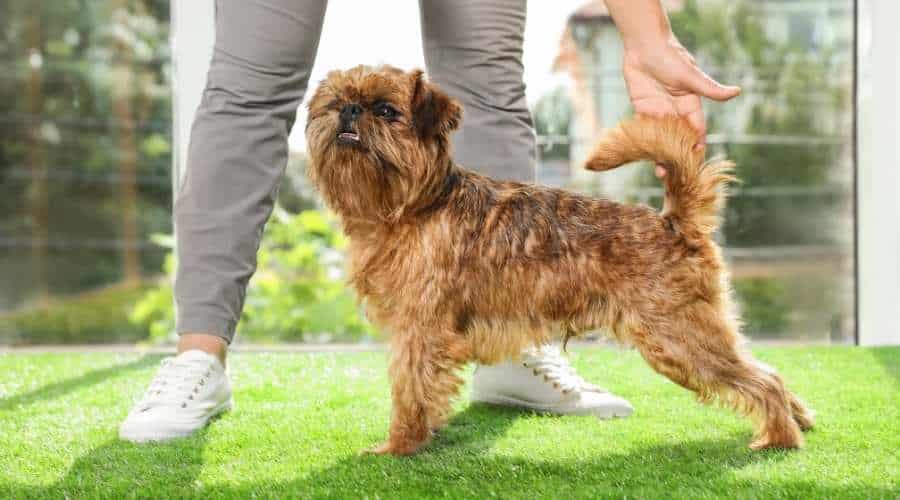
Housetraining can be a challenge, however. Until your Griff is completely trustworthy, waiting to go outside to eliminate, keep him with you or crate train him. Keeping him off of expensive rugs he could damage make sense as it will keep you both happy as the housetraining journey continues. Even as an adult, your Griff will need frequent access to go outside to relieve himself and avoid indoor accidents.
Health
Bladder Problems
Brussels Griffons can be more difficult to house train and less able to hold their urine than sporting, working, and herding breeds. They are also more likely to develop kidney or bladder stones than other breeds. Any time your dog has blood in his urine, strains to urinate, or cannot urinate at all, it is a medical emergency, and you should contact your vet immediately.
Brachycephalic Syndrome
The short, upturned nose that contributes to the distinctive character of the Griff’s face predisposes him to trouble breathing. This flat-faced conformation is scientifically described as brachycephalic. Your Griff will likely snore because of the way his face is shaped, but how this affects him depends on many factors. Because he is a brachycephalic breed, he could suffer from Brachycephalic Obstructive Airway Disease, which is sometimes referred to as Brachycephalic Syndrome.
If your dog has trouble breathing and overheats easily, visit your veterinarian to assess your options for treatment. There are surgical options for severely affected dogs, but the first thing to do is make sure your Griff is not carrying excess weight. Fatty deposits around his airways can obstruct narrow breathing passages further, and exacerbate his difficulty breathing.
Hip Dysplasia
Like many dog breeds, Brussels Griffons risk developing hip dysplasia. Choosing either an OFA-tested adult or buying pups from OFA-tested parents help mitigate the risk, but dysplasia also occurs from rapid growth as a puppy. Following your veterinarians’ recommendations for feeding him as a puppy can mitigate this risk. Joint dysplasia in the hips typically presents as lethargy, general stiffness, and signs of pain.
Patellar Luxation
Just like in people, the patella is the knee cap. The patella sits in a groove at the top of the shin. A luxating patella slips in and out of this groove, dislocating and stopping the knee from bending properly. Not only does this cause lameness, but it can also cause pain and arthritis.
Luxation of the patella is usually a genetic condition. Although it typically affects small breeds, it can be found in larger dogs. If you notice your dog holding a leg up for a few steps as he runs but then he uses it normally again, make plans to take your dog to the vet to check it out. This condition can lead to stiffness and arthritis later in life. Treatment varies with the severity of the condition. Mild cases of patellar luxation may be treated with NSAIDs to alleviate discomfort. In severe cases, however, surgery will be the recommendation.
Eye Conditions
Brussels Griffons also have issues with cataracts and PRA. Cataracts tend to appear with age. While surgery is an option for this disease with its recognizable cloudy appearance, many elderly dogs adjust to blindness as long as their owner makes accommodations.
If your dog appears to be losing his sight and there are no visible cataracts, he may have Progressive Retinal Atrophy. One of the most frightening aspects of PRA is that it is asymptomatic until significant loss of sight has already occurred. Your buddy may be unwilling to go into a dark room or may bump into things in a new environment. Visually, you have little to go on other than his retina, or retinas may seem shinier than normal. If you notice your dog acting like he struggles to see, make an appointment to have him screened. Unfortunately, there is currently no cure for PRA, but you can modify his environment to make things easier for him.
Anesthesia Sensitivity
Brussels Griffons present additional challenges when put under general anesthesia. Although most vets are aware of this anesthesia sensitivity, it is always worth mentioning should your pup need emergency surgery, dental cleaning, or anything else that requires sedation. Your vet will pay special attention to the prolonged recovery time your buddy may need from some intravenous anesthetics and the increased risks of drug interactions. They will also monitor for airway anesthetic recovery issues in short-nosed dogs.
Nutrition
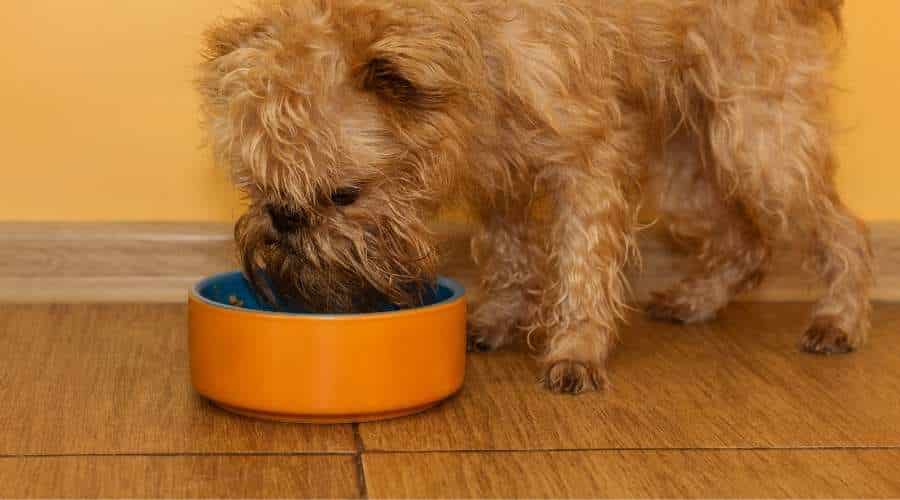
When he is a puppy, feed about a half-ounce of quality puppy food for each pound of body weight, broken into three meals per day until he is six months old. He will be small, so make sure the size of the kibbles you offer him is not too much for his puppy teeth to chew effectively.
As he grows, graduate him to an adult dog food balanced for toy breeds and feed him twice a day. Brussels Griffons are brachycephalic, and excess weight can make it harder for them to breathe. If your dog starts to gain excessively, you may switch to a weight control food, so his intake is the same volume-wise but lower in calories. Be sure he is exercising 30 minutes per day, but be careful about increasing the intensity, especially in hot weather.
Grooming
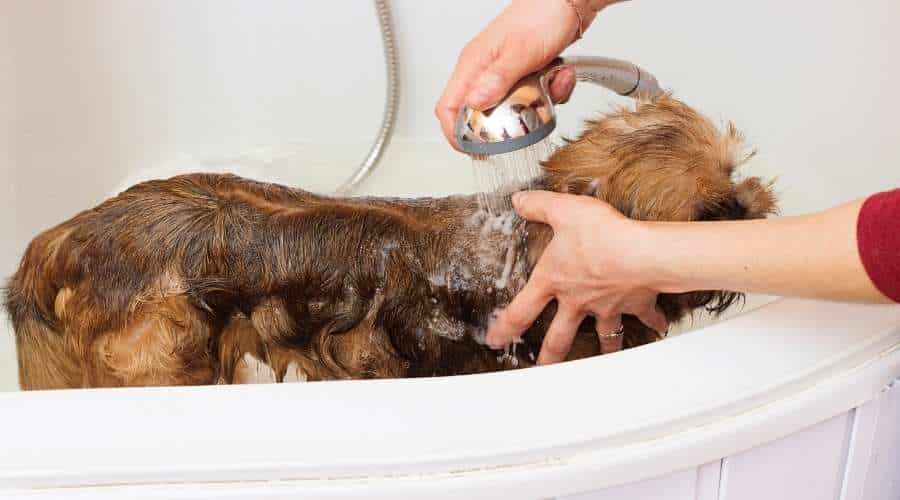
Smooth-coated Brussels Griffons stay sleek and shiny with a weekly brushing of the coat. Keeping them regularly brushed helps them as they shed between seasons. While the rough-coated variety doesn’t shed in the same way as the smooth Griff, their coat requires more work to stay neat and tidy. A professional groomer can hand-strip your rough-coated pup twice a year or as needed.
Breeders And Puppy Costs

You may expect to pay from $1,500 to $4,000 for a Brussels Griffon from a breeder. Show quality dogs will cost even more. Be sure the breeder you choose stands behind the health of his or her dogs.
Rescues And Shelters
Be sure to consider adopting a Griff. Although they are on the rare side, a lonely pup could be waiting for his forever home at a shelter near you. Adopting a dog is less expensive than buying from a breeder. Allow your new best friend time to adjust, and ensure his successful transition to your home by remembering that Brussels Griffons are sensitive, highly bonded souls. Allow him to be with you as much as possible but diligently facilitate his bathroom outings as you win hearts.
As Family Pets
While Brussel Griffons are devoted pets, they are not necessarily the right breed to be a family pet. A small child could easily hurt or frighten these dogs, even if the child means no harm. The Griffon’s diminutive size puts him at risk of inadvertent injury. His sensitive nature will not tolerate yelling or teasing.
In order for the Brussels Griffon to be a family pet, everyone in the family must understand his personality and handle him gently, both physically and emotionally. As he typically bonds to his primary caregiver, his entire human family will need to participate in his care for this dynamic to work.
Ideally, the Brussels Griffon is best suited to a retiree who spends a good bit of time at home or someone who works from home and values his company. A Griff wants to be with his favorite person. He wants to sit with you, sleep in your bed, follow you from room to room, and be your shadow. If you are seeking that sort of best friend, you’d be hard-pressed to find a more devoted sidekick than your Griff.
In general, this breed is:
- A very small, fun-loving dog who relishes gentle play.
- Known for his human-like facial expressions.
- Sensitive and devoted.
- Nicknamed a “Velcro dog” for sticking so close to his favorite person.
- Standoffish with strangers but may get along with older, gentle children
- Willing to challenge dogs larger than himself, so must be monitored in their presence.
- Eager to please but poses a challenge to house train.
- Able to squeeze out small openings in a fenced yard and liable to become lost.
- A one-person companion, and must learn to see the entire family as his special person if expected to be a family dog.
Final Thoughts
The Brussels Griffon will look to you as his whole world. He is playful one moment and a bit self-important and serious the next. His range of facial expressions will keep you enchanted, and he will shadow you from room to room as you spend your days with him at home. If your nest is recently empty or you’re hoping for a pocket-sized business partner as you work from home, you can’t find a more devoted best friend than your new Griff.



